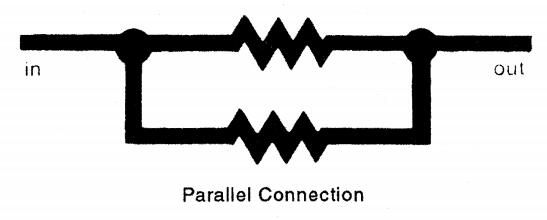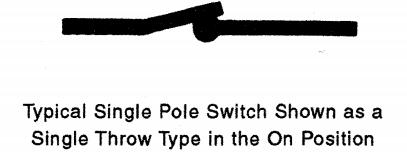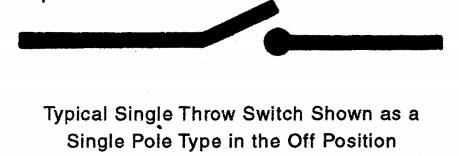In this article, we continue to talk abouit glossary of power generator terms.
Normally Closed-(Symbol N.C.) - As applied to a magnetically operated device such as a valve or the contacts of a relay, Normally Closed indicates that the valve or relay contacts are closed when no power is supplied to the operating magnet.
Normally Open- (Symbol N.O.) - As applied to a magnetically operated device such as a valve or the contacts of a relay, Normally Open indicates that the valve or the relay contacts are open when no power is supplied to the operating magnet.
Ohm - The unit of measure of electrical resistance. One ohm of resistance will allow a current of one ampere to flow with an applied potential of one volt.
Ohmmeter - An instrument for measuring electrical resistance.
Ohm's Law - A fundamental law expressing the relationship between voltage, current and resistance in electrical circuits. The law states that E = IR or voltage is equal to current times resistance.
Open Circuit - 1) A circuit that does not provide a complete path for the flow of current.2) A condition of an electrical circuit caused by the breaking of continuity of one or more conductors of the circuit; often an undesired condition. 3) An arrangement of conductors and equipment that depends upon lack of continuity for operation, as open circuit telegraphy; a circuit in which continuity is incomplete or interrupted.
Oscillogram - The permanent record produced by an oscillograph, or a photograph of the trace produced by an oscilloscope.
Oscillograph - A measurement device for determining waveform by recording the instantaneous values of a quantity such as voltage as a function of time.
Oscilloscope - An instrument primarily for making visible the instantaneous value of one or more rapidly varying electrical quantities as a function of time or of another electrical or mechanical quantity.
Oscilloscope, Dual Beam -- An oscilloscope in which the cathode-ray tube produces two separate electron beams that may be individually or jointly controlled.
Parallel Connection - An electrical connection in which the input of one element is connected to the input of another element. The output connections are similarly connected together thus providing two or more paths for current to flow.

Parallel Operation - The method by which generators having the same voltage and frequency characteristics are connected to a common load.
Permanent Magnet Generator - A generator which uses permanent magnets to create a magnetic field. As applied to Cummins Generators; a permanent magnet generator, within the main generator, supplies the power to the voltage regulator which in turn supplies power to the exciter field. The permanent magnet generator still supplies power during a short circuit of the main generator, This permits the main generator to sustain high short circuit currents. The output of the permanent magnet generator is electrically isolated from the main generator output and is not adversely affected by main generator output waveform distortion such as from SCR type loads.
PMG - See Permanent Magnet Generator
Polarity - An electrical term which indicates the direction in which current flows in a conductor. In a direct current system, current flows in the same direction. In an alternating current system, current changes direction as the polarity of the A.C. voltage source changes.
Potential - Another term to indicate voltage.
Potential Difference - The difference in voltage between two points in a circuit.
Power - Defined as the rate of performing work, Mechanical power is measured in horsepower or kilowatts. Electrical power is measured in kilowatts.
Power Factor - The ratio of the true power (KW) requirements of a load to the apparent power (KVA) requirement of a load. The combined loads applied to a power source may have a resistive, capacitive, or inductive effect.
Resistive loads such as incandescent lighting or resistive heating elements cause no shift in the voltage/current wave-forms and are therefore unity (1.0) power factor loads.
Inductive and capacitive loads, however, cause the voltage and current wave-forms to shift with respect to one another. These types of loads are commonly called power factor loads (i.e., the power factor is less than l.0),
See INDUCTANCE and CAPACITANCE for more information.
Power Factor is frequently multiplied by 100 and expressed as a percentage.
The formula for power factor is:

R – Symbol used to represent resistance.
Reactive Differential(Cross Current) Compensation - A circuit arrangement for operating generators in parallel with no generator voltage droop. Reactive Differential Compensation is accomplished by a differential interconnection of the secondaries of the generator current transformers used for Reactive Droop Compensation. This arrangement is not often used and is very difficult to set up when paralleling generators of different capacities.
Reactive Droop Compensation - A circuit arrangement that creates a droop in generator output voltage that is proportional to the reactive load current. This circuit arrangement makes paralleled generators share the reactive component of the load current in proportion to the generator ratings. It also can essentially eliminate the reactive component of circulating current which may flow between paralleled generators. The Reactive Droop Compensation arrangement is commonly called the Generator Paralleling Module.
Relay -- An electro-mechanical device having a magnetic coil which, when energized, opens or closes several sets of contacts.
Resistance - Opposition to the flow of current.
Resistor-(Symbol R) - A device or component designed to have a definite amount of resistance. Resistors are used in circuits to limit current flow or to provide a voltage drop.
Resistor, Fixed - A component which is used to control voltage and current by introducing a constant resistance of known value into the circuit.
Resistor, Variable - Similar to a fixed resistor except the resistance value can be adjusted. The voltage adjust-rheostat is a variable resistor.
Rheostat - A variable resistor.
Series Connection - An electrical connection in which the input of one element is connected to the output of another element providing only one path for current to flow.

Short Circuit - An abnormal connection (including an arc) of relatively low resistance, whether made accidentally or intentionally, between two points of different potential in a circuit. Equipment, not protected by fuses or circuit breakers, may be damaged by a short circuit.
Shunt Trip - An electro-mechanical device which, when energized, trips the main line circuit breaker.
Single Pole Switch - A switch which has only one of contacts.

Single Throw Switch - A switch which opens a set of contacts in one switch position and closes the contacts the other position.

Speed Droop - A decrease in steady-state speed of an engine due to an increase in applied load. This decrease in speed from the no load speed is expressed as a percentage of full load speed or:

Solenoid - An electro-mechanical device which, when energized, acts on a movable core or plunger in the center of the energizing coil to perform mechanical work.
Solid-State - A term which applies to electronic devices which are constructed using semiconductor material. Such devices include transistors, SCR's, and diodes.
Stability - Freedom from undesired variations or oscillation. In generator set systems, the generator set is stable if it can maintain or quickly re-establish steady state conditions of voltage and frequency after a sudden load change.
Surge Suppressor - A device capable of conducting current in either direction in the presence of high transient voltages thus protecting devices that could otherwise be damaged.
Synchronism - The condition where two or more generators are operating at the same frequency and output voltage and are in phase with one another.
Synchronizing - The procedure of matching the frequency, phase rotation, voltage and phase relationship of one generator to another for purposes of paralleling the units onto a common bus.
Synchronous - A generator whose output frequency is directly related (proportional) to the speed of the engine driving the generator.
Tachometer -- An instrument for measuring the rate of rotation expressed in revolutions per minute.
Temperature Drift - A change in the value of a component caused by changes in operating temperature.
Terminal - A mechanical device for making electrical connections.
Transformer - Frequently, a device using a laminated iron core with a primary and secondary winding. A transformer changes some level of input (primary) voltage or current to a proportional output (secondary) voltage or current. See current transformer and potential transformer.
Transient - A temporary change from the steady-state conditions.
V - Symbol used to represent voltage.
Volt - The unit of measure of electrical potential (voltage). One volt of electrical potential will force a current of one ampere to flow through a resistance of one ohm.
Voltage - Electrical potential or pressure which forces current to flow through a circuit.
Voltage Dip - A temporary reduction in voltage generally resulting from an increase in load.
Voltage Droop - A decrease in steady-state voltage of a generator due to an increase in load applied. This decrease in voltage from the no load voltage is expressed as a percentage of the full load voltage or:

Voltage Droop Compensation - A system which permits paralleled generators to share the currents of a load in proportion to the generator set ratings.
Voltage Regulator - A device which controls the voltage output of a generator at a preset value regardless of the amount of load applied.
Voltmeter - An instrument designed to measure electrical potential or voltage.
Copyright © Guangxi Dingbo Generator Set Manufacturing Co., Ltd. All Rights Reserved | Sitemap
Update cookies preferences